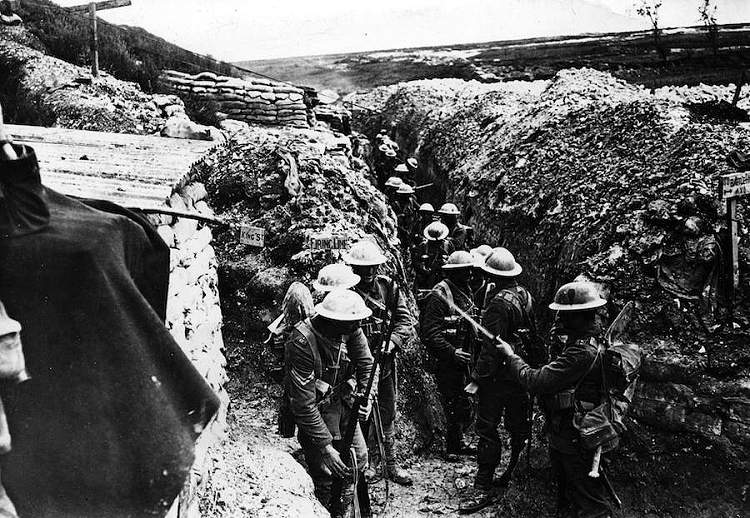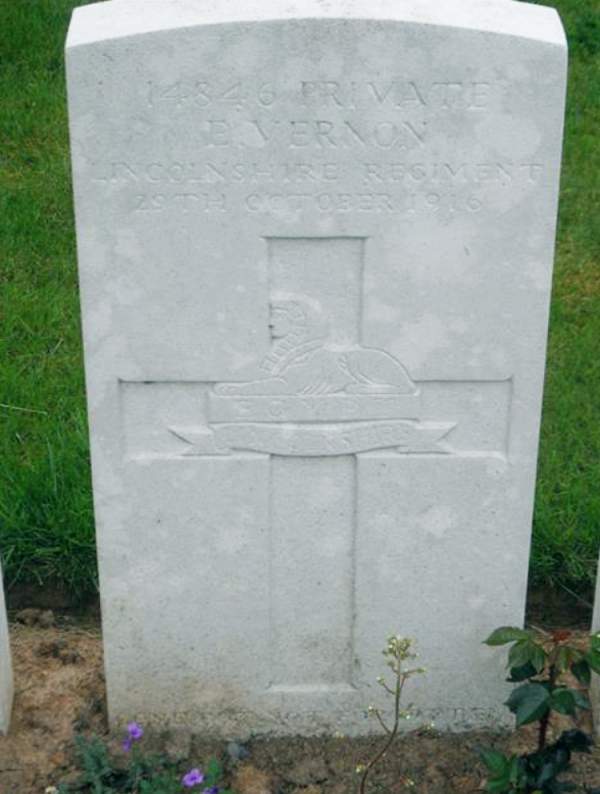Private Ernest Vernon, 14846, 2nd Battalion, Lincolnshire Regiment
Ernest Vernon was born in Ossett on the 7th January 1897, and baptised on the 7th February 1897 in Ossett. He was the second son of Thomas Vernon and his wife Alice, nee Brown. Ernest had an older brother George William Vernon, born 1894 also at Ossett. Thomas Vernon was born in 1867 at Retford and Alice Brown was born in 1865 at Doncaster, they were married on 19th January 1890 at Christ Church, South Ossett and Thomas Vernon, a railway porter. gave his age as 26 years. By 1891, the Vernons were living in Little Town End, Ossett.
In 1901, the Vernon family have moved to live in Kexby Rd, Lea, near Gainsborough and 34-year-old Thomas Vernon is now working as an agricultural labourer.
in 1911, both Ernest aged 15 years and his brother George William aged 17 years are working as farm labourers and now boarding with German national Richard Schmidt 21 years, also a farm labour, and his family at Holme, Kirton Lindsay in Lincolnshire.
Private Ernest Vernon enlisted in Gainsborough and served with the 2nd Battalion Lincolnshire Regiment. His medal index card states he first entered a theatre of war in France on the 1st June 1915. He was posthumously awarded the British War, Victory and 1914-15 Star medals.
The Fourth and Sixth armies were to attack on the 23rd October towards Le Transloy, ready to capture the village on the 26th October. On the left the 25th Brigade attacked the north end of Zenith Trench with the 2nd Lincolnshire Regiment.

Above: Waiting for Zero Hour in the trenches.
The War Diary for the 2nd Lincolnshire Regiment details the failed action to recapture Zenith Trench, west of Le Transloy, which ultimately cost Private Ernest Vernon his life:
23rd October 1916
"The Battalion assaulted Zenith Trench in 4 lines composed of two Coys, "W" on the right and "Z" on the left. "Y" and "X" Coys formed the second two lines in support of "W" and "Z" Coys respectively. The 2/Middlesex were on the right and the 2/Rifle Brigade on the left.
Zero Hour which was to have been at 11:30am was postponed to 2:30pm owing to fog. At about 1:45pm the enemy could be seen working along Zenith Trench on our right, obviously with the object of getting back to Eclipse Trench but owing to it being blocked they were unable to do so. This caused them to be very thick in numbers at our objective.
At Zero hour the battalion assaulted following a creeping barrage as close as possible. "W" Coy under 2nd Lieutenant Drysdale; "Z" Coy under Captain Burton; "Y" Coy under 2nd Lieutenant Spicer and "X" Coy under 2nd Lieutenant Coneybeare.
As soon as the Battalion started the assault a very gallant German officer ran down his own parapet and got his men up and they stopped us by rapid rifle fire. "X" and "Y" Coys immediately pushed on to support the first two lines, but suffered very heavily from machine gun fire and only a small portion of "W" and "Y" Coys on the right managed to reach the German Trench with the Middlesex Regiment who had captured their first objective with very slight loss. The Rifle Brigade on the left did not reach their objective.
5pm - The Battalion was collected and proceeded back to Rose Trench in Brigade Support."
There were 23 killed, 129 wounded and 120 missing after the abortive attack. All four officers leading the attack: 2nd Lieutenant J.D. Drysdale; Captain A.H.W. Burton; 2nd Lieutenant C.W. Spicer and 2nd Lieutenant H.W. Coneybeare were killed. Private Ernest Vernon was mortally wounded and died six days later.
Private Ernest Vernon, aged 19 years died of wounds on the 29th October 1916 at the 34 (1st West Lancashire) Casualty Clearing Station, Grove Town, Meaulte, France. The son of Thomas and Alice Vernon of Walkeringham, near Gainsborough.

Above: Private Ernest Vernon's gravestone at II.D.21, Grove Town Cemetery, Meaulte, Somme, France.
Meaulte is a village just south of Albert. In September 1916, the 34th and 2/2nd London Casualty Clearing Stations (CCS) were established at this point, known to the troops as Grove Town, to deal with casualties from the Somme battlefields. They were moved in April 1917 and, except for a few burials in August and September 1918, the cemetery was closed. Grove Town Cemetery contains 1,395 First World War burials.
Ernest Vernon is remembered on the St Mary Magdalene Church War Memorial bronze plaque, Gringley Road, Walkeringham. The inscription on the bronze plaque reads: "In sacred memory of the following men of Walkeringham who gave their lives for King and Country in the Great War 1914-1918."
Ernest Vernon's name was quietly added to the Ossett War Memorial with little or no notice in October 2023.
References:
1. Ancestry Family Trees for Ernest Vernon.
2. War Diary for October 1916 2nd Battalion, Lincolnshire Regiment.